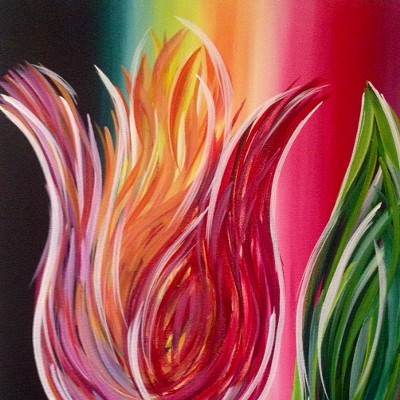Forkan deals with the human form in an expressionist style, but he is inspired by the most realistic of media: photography, specifically 19th-century daguerreotypes. Forkan, a sometime Tucsonan who freelances for the Weekly, begins each of the monotypes in one of his triptychs with the same image. Then he adds different layers on the separate monotypes, so that the original image changes until it looks bleached, scratched, blurred or marked.
In the series "Flow II," Forkan's barely visible figures create a sense of the passage of time. They are like old, fading photographs that hold memories lost forever because no one recognizes the people in the images. "Time Lapse--Elizabeth IV" seems more about the artistic process of painting, the movement from softer to bolder strokes. Forkan's series shifts between capturing the sense of memory lost and exploring form and style. Although they are both enjoyable, the images with the stronger exploration of memory are most satisfying because of their emotional resonance.
Tucsonan Bailey Doogan zooms into the literal skin of the human form. Three of her 12-inch-square, oil-on-canvas paintings are hyper-real close-ups of a middle-aged woman's skin. "Breasts, Age 59, 2001," "Stomach, Age 59, 2001" and "Pelvis, 59, 2001" reveal the sagging breasts, wrinkled skin and varicose veins that women usually try to hide. The images capture the second coming of age that woman dread and fight off with every means at their disposal. Such methods support billion-dollar industries.
The irony is that Doogan's images are beautifully painted. They are landscapes of color. The skin is not just painted in flesh tones, but in rose, mauve and pale yellow with blood-red pinpricks and a burgundy belly button. Despite their small size, these paintings are so intense that they make some viewers nervous. These close-up paintings of women's bodies are a natural outgrowth of the diptychs and triptychs of nude, aging women that Doogan did in the late 1990s, only those were immense black-and-white images in charcoal, dry pigment and aluminum dust on gessoed paper.
In this Etherton exhibition, Doogan also includes seven small paintings done in a cartoon style. According to Doogan, she began the series as a way of going beneath the skin into the internal body parts, and some of the images like "Fitzgig" are parodies of organic, intestinal and bacterial forms. Not surprisingly, Doogan found something more inside than writhing human organs for some images, like her ironic vision of a miniature prom queen lost in the internal world of blobs and veins.
Viewers should not be surprised to see something different from Doogan, who has reinvented her art many times in her four decades as an artist. Even though she is well known in Tucson as a painter, Doogan's initial training was in graphic design, and in the late 1970s she created an animated film.
Roberts is another artist who has made her way to her current medium through a convoluted path. Actually, her medium is mixed media. Roberts paints images in oils on black-and-white photographs. Sometimes she attaches all or part of the photograph to the canvas. Yet Roberts studied printmaking in college and majored in drawing in graduate school. By the time she received her master of fine arts from Arizona State University in 1980, she had begun painting on photographs.
Roberts, who now lives in Corrales, N.M., lived in the Zuni Pueblo in New Mexico for a decade. Through the years she has drawn heavily on Native American iconography for her imagery: deer, crows, kachinas and fetishes. Although this exhibition includes some such works, Roberts uses the layered nature of her media to explore the duality of human nature and experience. Unlike some of Roberts' recent works on canvas, the works in this exhibition are small, most only 6 by 9 inches or smaller.
In "Young Man Smoking" (one of the few large images, at 40 by 14 inches), much of the smiling man in shorts and T-shirt is visible in the photograph beneath the paint. Roberts uses white paint to draw a basic skeleton and lungs on top of the photograph. The man's face is split between the forward-facing, smiling photo and the painted profile blowing smoke out like steam. Roberts gives the man tiny arms and hands, so that he holds a white cigarette with a glowing tip in miniature fingers. It's a creepy, almost corpse-like vision of death by lung cancer in the making.
Santiago, who splits his time between Tucson and western Michigan, captures the women in his realistic portraits as they turn their heads or lift their eyes, at just the right moment to make them lovely or seductive. Dressed in strapless dresses or in gowns studded with flowers, these women are almost as elegant as the subjects of 19th-century court portraits are. Instead of lush garden settings or the trappings of royal apartments, the backgrounds in Santiago's portraits come from modern art: squares of color stacked to form the top of the Christian cross.
Why everyone lives in the shadow of the crucifixion is not clear, although Santiago's second body of work includes an ironic crucifixion scene. Where his portraits, which are beautifully painted in pigmented ink and acrylic on canvas, are realistic (albeit a bit romanticized), Santiago's second series owes a great debt to the early 20th-century Surrealist painter René Magritte.
Magritte repeatedly combined headless, dismembered, nude statues with landscapes, often using a blue sky with floating clouds. Santiago uses this Magritte motif in two of his paintings. In "Crucificio" ("Crucifixion"), a headless, dismembered male mannequin is nailed to a cross. In "Birth of Venus," the mannequin floating in the sky is female, and she is wearing a lacy black teddy. (The title "Birth of Venus" refers to Sandro Botticelli's classic image of the goddess Venus riding the waves on a clamshell.) Santiago has converted the ground into a black-and-white linoleum floor, but his images are too close to the Magritte originals to seem truly his own.
Even though Santiago depicts women's beauty and religion in almost all his portraits, he certainly has a sense of irony about them. After all, he's willing to set the birth of the Greek goddess of love and the death of the Christian god in a Surrealist's bizarre landscape.










